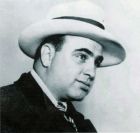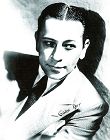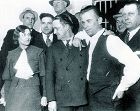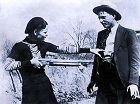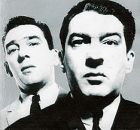Found Pages: The Remarkable Harold Ernest (“Darcy Glinto”) Kelly, 1899–1969.
Sidebar 11: Gangdom
“Made it, Ma! Top of the World!”
James Cagney in White Heat (1949)The underworld in Britain is more secretive and less glamorous than it is in America. Except for the Kray brothers’ brief dalliance in the limelight, British gangsters have operated to unobtrusively that they have sometimes seemed invisible.
Robert Murphy, Smash and Grab; Gangsters in the London Underworld 1920-60 (1993)I
Gangster fiction?
Fiction about gangsters, presumably.
But not any old gangsters, like members of those nineteenth-century Lower Manhattan gangs that Herbert Asbury wrote about so entertainingly in The Gangs of New York and Martin Scorsese filmed.
Or, for my purposes here, the barrio gangs in Los Angeles.
Or British mobs in the Twenties and Thirties, with their razors and coshes.
No, gangster fiction here means British authors writing about American gangs or about British gangs that resemble American ones.
But what American gangsters?
Quintessentially, Al Capone in Chicago and rural operators like John Dillinger.
II
So what is it that we have with the Capone kind? What is—or was, in the Britain of the Forties and Fifties—the allure?
Forceful and at time ruthless leadership, obviously. Lieutenants, footsoldiers, power, organization—the kind that gets somewhere, has momentum, With the money rolling in and (bad mistake) untaxed. What you make you keep.
Effectiveness.
And, of course, sex, with showgirls minked, worn on the arm, embedded in satiny love-nests, dumped when they pall, thumped when they lip back once too often.. All of them things in short supply in post-war Britain.
But also a kind of social centrality, making Capone figures both threatening and attractive.
They provide services desired by the well-to-do—booze, drugs, gambling, women—which bring the well-to-do into social contact with them, principally at night clubs, which they’re likely to own or have shares in.
Some of them, at least, know how to wear evening clothes and ingratiate themselves with city officials and members of the upper classes. They watch in movies the selves that they would like to be.
Some even know George Raft!
Scorsese’s Bill the Butcher would never get past the front door. Nor would Graham Greene’s vicious little loser Pinky Brown, in Brighton Rock, with his terrible cheap suits and bad teeth.
Up to a point, the Capone-type relationship with the well-to-do is de haut en bas, in the mobsters’ own favour. If you need liquor, you need a bootlegger, and you’d better be civil to him.
III
During their heyday, 1927-33, gangsters in the right clothes, mimicking the decorum of the ruling classes, look good to the spirited young, the rebels, the despisers of the ruling elite, conscious of the absurdities of Prohibition and Presidents Harding, Coolidge, Hoover.
Everyone had come to Gatsby’s parties in 1922, (Bootleggers were already making fortunes.)
Capone himself is a star, a celeb, an articulate public charmer, an efficient ethnic businessman coping with violent rivals, and less heartless and causing far less human wreckage than so-called captains of industry (aka robber barons) like Rockefeller, Carnegie, Frick, and Chicago’s own Philip D. Armour.
1927-1933 are the great years of fictional American gangdom, on paper and celluloid.
They are also the years of the colourful rise of “Kingfish” Huey Long, populist Governor of Louisiana from 1928-30, U.S. Senator from 1930.
His 1932 State Capitol Building, its marble and polished brass appointments accommodating spittoon-pinging gallus-snapping legislators, soars symbolically (but symbolic of what?) above scrubby Baton Rouge.
IV
But gangs aren’t static. They expand their operations, fight one another to the death, move in on businesses like dry-cleaning, corrupt sports activities. Their pineapples and Tommy-guns take out innocent by-standers. You can bet they were terrible shots with handguns.
The St. Valentine’s Day Massacre in the year of the Crash, 1929, creepily mingling the reds of love and death, isn’t fun, isn’t a conventional shoot-out. Seven members of Bugsy Moran’s gang are lined up facing a garage wall and killed with Tommy-guns, a sawn-off shotgun, and a revolver by Capone’s men disguised as cops (another inversion). “The St. Valentine’s Day massacre came to symbolize America’s scourge of gangsterism, racketeering and gun-crime.” (Andrew Roberts, A History of the English-Speaking Peoples Since 1900, p. 193). It even upsets the Eastern criminal fraternity and sends them into conference.
With Roosevelt’s election, the repeal of Prohibition, the shipping of Capone off to the Rock in San Francisco Bay, and the knowledge that a self-confident statesman as good with the media as Big Al is finally in charge again in Washington, the allure fades.
With Prohibition terminated, there are no longer across-the-social-spectrum services for gangsters to perform.
The FBI, under Tommy-gun-toting J. Edgar (at least in PR photos), is a bigger and more power-charged counter-gang, the “G” in G-Men inevitably suggesting Gun-men.
Apart, for a while, from rural badmen like John Dillinger, Bonnie and Clyde, the Alvin Karpis/“Ma” Barker gang, who aren’t really gangsters at all but outlaws relieving the banks of the money that they and their big depositors stole. And there are political developments elsewhere.
V
The National Socialists in power from 1933 are preeminent gangster politicians.
With his political savvy, his ruthlessness, his charm when needed, his modernity (as against all those hidebound Prussians), his “vision,” and his popularity with lots of the public, Germany’s Adolf is a Capone figure, stage-centre later in Brecht’s The Resistible Rise of Arturo Ui (1941).
Like Capone, he is providing things that people want and that have been denied them by words on paper made into law in 1919, including a restored pride.
Goering, Goebbels, Himmler, and the rest are perfect gangster type-casting. When Himmler’s black-garbed SS in the 1934 Night of the Long-Knives take out the leaders of scarred-face Ernst Röhm’s rival SA Brownshirts, it has a St. Valentine’s Day Massacre absoluteness.
An unsympathetic observer in the early Twenties has Hitler going to soirées in “his gangster hat and trenchcoat.” (q. Ferguson, p. 233)
Unlike Stalin, Hitler as master gang-boss leaves the rest of his inner circle largely free, endowing them with power and giving them the gift of security. Virtually the same cast stays with the show all the way through to the Nuremberg Trials.
The Nazi gang view other European countries, the “community of nations,” the way Capone views the agents of so-called law and order.
These German guys are dangerous. They are at the center of Europe.
Mussolini, strutting beside the Mediterranean and making Johnny-come-lately grabs in Africa, is too marginal to be really menacing. True, he has a navy—but an Italian navy.
He can’t do a reverse-Hannibal over the Alps.
VI
Back home, in May 1934, the proverbial hail of legal bullets eliminates doomed lovers Clyde Barrow and Bonnie Parker near Gibland, Louisiana.
In July, Public Enemy Number One, John Dillinger, is shot dead by FBI agents outside the Biograph movie theatre in Chicago, where he’s been watching Manhattan Melodrama, a gangster movie with Clark Gable, William Powell, and Myrna Loy.
The following year Kate (“Ma”) Barker (“Bloody Mama”) and son Fred, remnants of the Barker/Karpis gang (kidnapping among its activities), die in a shoot-out with the FBI near Lake Weir, Florida. Later J. Edgar would call her “the most vicious, dangerous and resourceful criminal brain of the last decade … a veritable beast of prey.” Alvin Karpis opined that she was greatly overrated.
Eight movies in that year, 1935, feature G-Men heroes, several of them with James Cagney. Hollywood had decided, no more gangster-viewpoint movies.
That year, too, Huey Long, preparing to challenge Roosevelt for the Democratic nomination, dies, Caesar-like, of bullet wounds received in his Capitol Building and is later given fictional immortality in Robert Penn Warren’s All the King’s Men (1946) and Robert Rossen’s 1949 movie of that name.
In Angels with Dirty Faces (1938), Cagney goes yellow to the gas-chamber on behalf of Father Pat O’Brien. In The Roaring Twenties (1939) he winds up driving a cab. Humphrey Bogart is so convincingly odious as a gangster in that movie and in ones like Dead End and Kid Galahad (both 1937) that you’re surprised he could ever achieve loveableness.
VII
In Britain, the crucial difference is they haven’t needed a bootlegger or speakeasy for a pint of bitter or a pink gin.
If you are a Bright Young Thing or wannabee in the Twenties, you can drink after hours in dodgy Soho nightclubs like Kate Meyrick’s 43 where, as Robert Murphy puts it in his superb Smash and Grab; Gangsters in the London Underworld 1920–1960 (1993), “the underworld and the aristocracy met on equal terms, free-spending burglars like ‘Ruby’ Sparks mingling with the owners of the jewels and furs from whom they stole.” (p.8). You can buy white powder there, or through contacts made there, if you are flapper enough.
But decent citizens simply frequent their wine-merchants, or clubs, or pubs.
In those years, the underworld does indeed, as Murphy says, perform “a number of illegal but indispensable social services, supplying prostitutes, drugs, gambling and out of hours drinking facilities to the public.” But in large part these are culturally shadowy, class-wise, either because they are beyond the pale, like prostitution, pimping, and drugs, or because, like street gambling, they are working-class. The only visible arenas are the race-tracks, where gangs compete for the privilege of working the very lucrative protection racket on bookmakers.
The images of effectiveness have largely been upper-class—“Sapper’s” Bulldog Drummond, Buchan’s Hannay, Leslie Charteris’ Saint, Dornford Yates’ treasure-finders, Edgar Wallace’s Mr. Commissioner Sanders of the River, etc. E.W. Hornung’s burglar A.J. Raffles, as Orwell points out, is a gentleman (even if not always gentlemanly).
The “gangs,” whether native emulators or from the States, are principally forces of disruption that have to be fought and subdued, not just physically.
The real-life ones are East End. They have their own strong cultural identities and value systems—in part, displaced “aristocratic” ones, continuations of the rakishness of the Regency years. A real man never works. A real man takes major risks. A real man is a lavish spender.
But all this is working-class and intellectually unchallenging, morally or politically. Apart from the abortive General Strike of 1926, and in contrast to the quasi-Syndicalast strike actions around 1911-13, the working class, in face of the omnipresent postwar threat of the sack, is basically docile.
Its youth, though, can still be influenced for the worse, as can the young of its betters.
VIII
America is more problematic, ideologically, than Russia.
Bolshevism is too alien and wicked, particularly after the butchering of the Russian Royal Family, to appeal to more than a relative handful of the middle and upper classes, mostly young. The Communist-energized General Strike of 1926 lasts a bare nine days.
America is partly an extrapolation from Britain, an intensification of elements in it, and hence more insidious.
In Establishment eyes, there are two Americas. The good America is Lincoln, Little Women, Fennimore Cooper, Mark Twain, Hiawatha, etc. The Bad America is the St. Valentine’s Day Massacre, the lynchings, chain-gangs, and Klan floggings in the South, the armed traffic cops, the spotlights and rubber hoses of “third-degree” interrogations.
But there is also a third America, the America of heroic outlaws and high-energy criminal aspirers, particularly in the movies, particularly in the figure of Irish Cagney. “Gangs,” after all, had originally been Irish work gangs, and the 19th-century gangs of New York, as described by Herbert Asbury, had been sociable as well as criminal organizations.
Given the mess that the ruling class have made of things during the War and the ensuing poverty, there is something to be said for dis-orderliness.
IX
British movie censors in the 1930s are concerned to keep out, or muffle the impact of, “American” violences in gangster and horror movies. Certain kinds of actions should remain, as far as possible, unthinkable in a civilized country.
The tortures and undescribed abominations touched on in Rider Haggard, Kipling, Buchan, Conan Doyle, Edgar Wallace, boys’ magazines like the pre-1914 Chums , and faux-Imperial Hollywood movies like Lives of a Bengal Lancer (1935) are off in exotic and by definition uncivilized parts, or else back in the Catholic darkness of the Inquisition, or beyond the pale among the hirsute Bolsheviks.
They aren’t disturbing in the same way as racetrack gangs intimidating bookies, or Brownshirts smashing the windows of Jewish stores in Berlin, or the 1936 street-fighting when Oswald Mosley’s Blackshirts march through the Jewish East End.
With his rasping un-English oratory, Mosley never really has a chance at power in England. But his thugs beating up hecklers at the Albert Hall and the Olympia Stadium show that some things, under the right circumstances, could happen here.
X
“Civilized” controls work, though.
Fighting at Lewes racecourse between members of the rival Sabini and Whites gangs results in sentences totalling fifty-three years for sixteen men.
In the same year, 1936, Parliament bans political uniforms.
Around this time, too, the Flying Squad and some heavy sentences effectively put a crimp in smash-and-grabbery. Everyone knows that where the judge’s black cap and the hangman’s bag are concerned, it makes no difference if a killing during the commission of a crime is unintentional.
And London is still a city in which “murders, at about a dozen a year (not including infanticides) are very rare, and there are on average only about a hundred robberies with violence.” (Fergus Linnane, see Note 10.) Robert Murphy reports that the sentences for criminal-on-criminal violences are relatively light. The heavy ones are for offences against property. By and large, crooks and cops have something like a modus vivendi, a sense of their interactions as governed by unofficial game rules.
In Golden Age crime fiction, men go on discreetly poisoning nagging wives, and rich relatives, and bothersome business associates. They always get caught, thanks to gentlemanly (or ladylike) private snoops and officer-class coppers.
But Eric Ambler, James Curtis, Graham Greene, and others provide some newer-style Realpolitik violences. It is as if, in that dispiriting decade, with the ruling classes looking steadily worse in the light of ascendant fascism abroad and poverty at home, writers have abandoned, at least in certain novels, the attempt to see things in chivalric terms, and are learning things themselves about the under-class resentments out of which support for fascism can arise.
For a wincingly perfect encapsulation of British class attitudes when dealing with the “Continental,” see Hitchcock’s original 1934 The Man Who Knew Too Much.
XI
1939–45. New men. The Black Market. Bootleg whisky, bootleg cigarettes, bootleg nylons, bootleg, bootleg. Some things can happen here. Big money.
In the memoirs of gangster Billy Hill, ghost-written by crime reporter Duncan Webb, we hear that in the first year of the war,
It seemed that London had got over the first shock of the war and had now adjusted itself to a new and strange existence. To a great extent the black-out and a depleted police force increased the opportunity for crime. So did the loose money which was flying aout the country. The result was that the West End became a roaring square mile of bustling prosperity and activity. Women flocked from all over to walk the streets and haunt the hotel lobbies, bars and clubs. Good-time girls became brazen tarts, ordinary wives became good-time girls. Small-time tealeaves turned into well-to-do operators. In the netherworld of pubs and clubs, of speilers [gambling dens] and dumps, you were assessed by two things, the amount of money in your pocket and your connections on the black market. As you know, a pair of nylons could buy a woman’s body, a diamond ring could buy her for life-or as long as you wanted. (Boss of Britain’s Underworld, 1955, p. 76)
For more, by one of the players, see Note 37.
Bt the end of the War there are handguns around, deserters, impatient toughened ex-servicemen, a lot of money to be made by stealing and selling basics and luxuries in exasperatingly short supply.
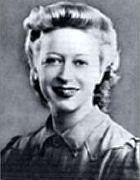
Elizabeth 'Marina' Jones
At the Old Bailey in 1945, the Cleft Chin killers, 22-year-old American deserter Karl Gustav Hulton and 18-year-old Elizabeth ‘Marina’ Jones are sentenced to be hanged by the neck, both of them. for cold-bloodedly murdering a taxi-driver during a mini-crime spree. They also ran down a girl on a bike and robbed another one, knocking her out and tossing her into the Thames. (Waller, pp. 246-7)
In “The Decline of the English Murder” the following year, after contrasting this murder with the “typical” English one (quiet domestic middle-class poisoning), George Orwell comments, “Perhaps it is significant that the most talked-of English murder of recent years should have been committed by an American and an English girl who had become partly Americanized.”
XII
For others of us back then, though, America, inaccessible America, is plenitude, and glamour, and charm, and romance, and self-expressiveness.
It is “Don’t Fence Me In” and “San Fernando Valley,” it is Jinx Falkenberg, and Veronica Lake, and Ann Miller, and Dorothy Lamour.. it is Bing and Bob on the Road to Morocco, with Bing, the distilled essence of relaxation, singing “Ain’t Got a Dime to My Name” and “Moonlight Becomes You.” It is “South Rampart Street Parade” and “St James Infirmary Blues.” It is Blues in the Night, with Betty Field. It is that alternate wartime American national anthem “In the Mood.”
It is California, and motels, and bourbon, and elevators (not mere “lifts”), and cars (with no petrol-rationing), and comfortably loose-cut clothes. It is freedom from the curse of the English class system.
There’s a lovely homage to America by brother Frank in Ted Lewis’s 1970 masterpiece Jack’s Return Home (the nearest thing to a British Gatsby) when Jack and he are kids together around 1950, with Britain still in the grip of Labour Government austerity, and thirty pounds, or was it fifty? was the maximum that you could take out of the country.
“That’d be the place, though, wouldn’t it? Imagine. Those cars with all those springs that rock back and forwards like a see-saw when you put the brakes on. You can drive one of them when you’re sixteen over there. Just think, our kid. Driving one of those along one of them highways wearing a drape suit with no tie like Richard Widmark, with the radio on real loud listening to Benny Goodman. “(Pan Books, p.75)
America, the America of prairies, and bayous, and real mountains, and individual states is so big. There’s always a somewhere to make a getaway to.
Across the Channel, in the darkness of Henri Langlois’ and Georges Franju’s Cinémathèque in the Rue d’Ulm, American cinema is adored, hour after enchanted hour, by future movie-makers like Truffault and Godard.
Partly it is the look of things American, the more emphatic design elements and self-presentation that make a copy of Life so much more energetic—all right, sexy— than Britain’s Picture Post and have American movie stars embodying offscreen (courtesy of studio PR) the same energies that they display on it.
Having a lot more money to put into production values doesn’t hurt, of course.
The 1946 Blue Skies (Stuart Heisler), with Bing and Fred wholly comfortable with their own skills, and lots of Irving Berlin numbers, and substantial nightclub and theatre stagings, would have been impossible in the Britain of that year.
Those lucky Yanks!
XIII
In worn-out post-war-austere, hyper-regulated England, with Nazism dwindled down to rubble, suicides, and caged baddies awaiting trial, America looks pretty good to some as a land of opportunity, even if envied and resented by others.
America in 1939 was isolationist America, cigar-chomping-Congressmen America. America in 1944–45 smashes its way onto the Continent and then takes care of the Japs.
Organization, energy, commitment, focus, effectiveness.
XIV
The fastest way to get rich in post-war England, if only in imagination, is crime.
Crime boss Jack (“Jack Spot”) Comer recalls of his Buttolph Club at Aldgate in the East End after the War finishes.
We had a rum mixture. There were big businessmen. There were bookmakers with pockets full of sucker money. There were spivs and screwsmen from the underworld getting rid of the cash they had picked up for the gear they had stolen. And of course the biggest players of all were the black-market boys. (quoted by Linnane, p. 132)
Crime reporter Arthur Helliwell tells how,
I watched gin rummy being played for £1 a point. I saw a Slippery Sam school where the kitty averaged between £200 and £250 a hand. I drank a glass of champagne with a suave, silver-haired, slickly tailored character who takes a rake-off on a £15,000 to £20,000 turnover every time he runs a chemmy party.
According to Donald Thomas in An Underworld at War (2003), you would mostly need to multiply by 40 to get equivalents in present-day pounds. I wonder if the figures here have been adjusted to convey their impact?
XV
This is still Britain, though.
For a few years, Spot is a fleshy, genial, self-confident, cigar-smoking Godfather type, organizing big heists, negotiating truces, flattered to be compared by newspapermen to Capone, and very largely prison-free.
A lot of his ideas [Clarkson reports] came from a veteran New York Hood called Sam Clines—onetime member of Murder Incorporated—whom Spot met in Soho just after the war. … Clines told Spot a lot about the way the underworld operated in cities like Chicago and New York. He even taught Spot how to run a crap game …
Under Clines’ tutelage he starts dressing beautifully, and his boys look “like a bunch of American gangsters in a Jimmy Cagney movie.” (pp. 76-77)
But I don’t recall ever reading or hearing of Spot in the Forties. Or about up-and-coming associate and rival, chiv-wielding Billy Hill, who one way and another spends seventeen years behind bars.
You couldn’t live in Prohibition Chicago and not know of Scarface Al Capone. You almost couldn’t live anywhere and not know of him. Romeo, Shylock, Casanova, Napoleon, Frankenstein, Sherlock Holmes, Tarzan, Al Capone. Who else?
A couple of tacky street fights with razors and knives in the early Fifties hasten Spot’s downfall. When you’re a knife-and-razor man, it’s less blessed to receive than to give. And then to be in the limelight in court, when the Press is shocked—shocked!—to learn that there is organized crime in England! Not good.
Ironically, Spot’s affection for his non-criminal wife, beautiful, brave young Catholic-Irish Rita and their two young daughters has already weakened his authority. It’s hard to be a good family man and a crime boss, and (in Clarkson’s account), the emerging Kray twins, who despise Spottie, have been manipulating Billy Hill into leaching power away from him. Not that Hill, envious and coldly calculating, organizer of two or three stunning daylight robberies, has needed much encouragement.
Hill reads the signs and, with his fortune still intact, follows Spot into retirement before Ronnie and Reggie Kray, especially Ronnie, who yearns to be American, get up full steam and become social darlings.
Spot, bankrupt, humiliated by Hill and the Krays, bereft after a while of wife and daughters (Rita returns to Dublin), serves out his last thirty-some years in low-paying non-criminal jobs, increasingly forgotten, still well dressed, and, by the sound of it, stoical. A melancholy story.
No “Come and get me, coppers” and blazing-guns exits here.
The Krays, complemented by South London crime bosses Eddie and Charlie Richardson, are another story, of course. See Stephen Vardin’s excellent www.thekrays.co.uk/story.htm. See also Note 58, “The Richardsons.”
XVI
Necessities for ideal gangs: places to assemble for pleasure and self-presentation (night-clubs, gambling clubs, sporting events); savoir faire (how to cope with a maître d’, a croupier); women; more women; big fast cars (imagine squeezing into a Morris Minor for a getaway!); hand-guns; submachine guns; pineapples (the disintegrating kind); role-models, movies, books—How to Be a Gangster; friendly newspaper reporters agog for your wit and wisdom; bent coppers; rivals (one hand clapping is no fun).
It would all arrive, in British movies, in 1980 with John Mackenzie’s The Long Good Friday and Bob Hoskins superb as a would-be British Capone—or, if you prefer, the Napoleon that Capone probably saw himself as.
A crucial step has been the opening of legal gambling casinos in the Sixties where classes can comfortably mingle—and where power flows from the pockets and purses of rich players into the hands of the casino owners to whom they owe more than they can afford.
XVII
It would be hard writing halfway decent novels about British gangsters after the war. You’d need to know too much, mingling with them, picking up speech patterns, risking seeming silly if you got things wildly wrong (crooks read books and earlier, some of them, had despised Edgar Wallace), risking seriously annoying dangerous men if you get them too right. Besides, you might not even get into their company.
There’s also the inhibiting pressure of British decency and feeling still for fair-play in Orwell’s fashion, not to mention a distrust of too much ambition as summarized in the Daily Mirror-ish put-down term, “big ‘ead.”
With American gangsters, you’ve already got plenty of movie models and patterns. Plus the 1939-41 novels of Chase and Glinto. Plus such wartime Americans as you may have run into or sought out—enviably better dressed, better paid, better fed, with allusions no doubt to plenitude back home in the land of drugstores, baseball, moonshine, Coca-Cola, and T-bone steaks.
Only one Glinto novel, so far as I know, is set in Britain, The Hangman is a Woman (ca 1953).
At least, as a writer, you can become American in imagination.
Actual America is largely terra incognita. In Gian-Carlo Menotti’s 1950 opera, the Consul is permanently busy—and anyway, even if you can obtain a visa, you’re not going to be able to get hold of legitimate dollars, not with Britain’s massive debts after Harry Truman terminates the Lend-Lease programme in 1945.
XVIII
Gangsters, almost by definition, are American after the War, particularly in their movie definings. You won’t find any glamorizing of British ones in those great organs of moral indignation the Daily Mirror, Daily Mail, Daily Express.
Ex-officers doing small-boat smuggling or free-lance thieves on the run are simply continuations of wartime patterns
The Atlantic is the moat across which you can safely gaze in imagination at the beasts in the jungle, red in tooth and claw as they fight to the death.
And mate. Which is not so easy in actual England, with the housing shortage, the scarcity of “low” hotels, the danger of pregnancy, the hunger of girls for marriage (often wartime-delayed), the general ignorance of sexual matters.
If you’ve been demobbed and want some feeding of the imagination stronger than what the movies provide, sex as well as the thrills of gunplay is on the wants list.
Without, necessarily, the obligatory marriage at the end of the entertainment. Marriage in post-war austerity England means cramped quarters (still there in the Fifties in Look Back in Anger), food and clothing shortages, and entertainment a Saturday night movie and a pint at the local.
XIX
There’s some unfinished moral business, too. How would you have behaved yourself had you been in Occupied Europe, with the trench-coated Gestapo around every corner?
Torture? Rape?
Wartime, with its problematic moral climate, doesn’t just stop when surrenders are signed.
Gangland, the imagined American gangland, can be where temptations are yielded to and moral heroism isn’t a sine qua non. Where a kind of moral decompression can go on.
An environment of danger and betrayal, a loss of the simple certainties of wartime movies, an acceptance of the fact that good guys, and good girls, don’t necessarily win through in the final reel.
XX
Describing the post-war years, Linnane reports that the Kray twins:
had modeled themselves on the gangsters in American movies, and to some extent on the real thing. They enjoyed the company of George Raft, who was both movie gangster and associate of the Mafia, when he came to London to pursue gambling-club interests. He was eventually barred from Britain because of his Mafia connections. Ronnie met the American mafioso Angelo Bruno, who also knew [British-Italian] Albert Dimes, when he was in London. The twins dealt in stolen American securities in association with Mafia-linked American criminals. This was to be one of their bigger money-spinners. (pp. 174-5)
Hitherto the British criminal fraternity have been missing a vital element. Its members haven’t been shooting each other—shooting to kill. Razors, coshes, iron bars, knives, beatings. But not, in the shadow of the British judges’ black caps, potent with the power of life or death, killing.
The Krays have no problem with killing people, Ronnie especially. He likes it.
Powers of life and death.
With their chain of clubs and charitable works, Reggie and Ronnie are celebs, media darlings, untouchable (seemingly) by the police, their connections extending into the House of Lords.
Schizophrenic Ronnie adores the limelight, and is greatly feared.
For the Richardsons, as I've said, see Note 58.
XXI
Sometimes it takes a generation for a form to realize its full potential.
In 1970, Ted Lewis, energized no doubt by the month-long 1969 trial of the Krays and seven other members of the Firm, and the Richardson trial a couple of years earlier, with accompanying revelations of gangland types and practices, explodes out of the box with Jack’s Return Home (aka Carter) and everything changes.
BC/AC, Before Carter/After Carter.
A perfect rendering of Kray-time British gangsters in an Americanizing England. A poignant sense of lost innocence. A marvellous ear for dialogue. Superb writerly skills all round.
The nearest thing to a British Gatsby. (See “The Best Thriller” elsewhere in this site.)
With unforgettable violences.
Hometown gang-boss Cyril Kinnear { “You see what it’s like, these days, Jack”) sneers at wannabees for whom being tough consists of “practicing fifty breaks of snooker and reading Hank Janson.”
Those aren’t the denizens of Jack’s Return Home, or the inexplicably unfilmed Jack Carter’s Law (1974), or Ted’s end-of-the-line GBH (Grievous Bodily Harm, 1980), whose torturing couple ,George and Jean Fowler, bring to mind the Krays’ south-of-the-river rivals Charlie and Eddie Richardson, sent down in 1967, along with “Mad” Frankie Fraser, for a long time—in Charlie’s case, a very long time.
In 1970, James Fox and his fellow thugs in the protection racket are convincingly violent in Donald Cammell and Nicholas Roeg’s Performance, The following year, Mike Hodges brilliantly transposes Jack’s Return Home to Newcastle in Get Carter, with Michael Caine (“In a thin glass”) at his peak as Jack. We’re off on the road to The Long Good Friday, and Lock, Stock, and 2 Flaming Barrels (1998), … and … and …
Ted’s one attempt at faux-American, Boldt (1976), is his worst novel, worse even than Jack Carter and the Mafia Pigeon (1977).
Genres can burn out. Who needs faux-American when there’s real British?
With an escalation of unamusing viciousness, as in Paul McGuigan’s Gangster No. 1 (2000), with Malcolm McDowell and Paul Bethany.
Realworld?
I’ve no idea.
XXII
The apotheosis of romantic gangdom comes during the heyday of Hong Kong cinema, ca. 1987–1994.
Chow Yun-Fat, Andy Lau, Anita Mui, Samo Hung, Joey Wong, Tony Leung, Jackie Chan, Kent Cheng, Maggie Cheung, Danny Lee, Simon Yam, Ti Lung, Rosamund Kwan, Michelle Yeo, Anthony Wong, others, others.
A galaxy!
Sidebars:
- Sidebar 1. Some Orchids
- Sidebar 2. Chase and Glinto
- Sidebar 3. The Pre-trial Glintos
- Sidebar 4. Deep South Slavery
- Sidebar 5. Darcy Janson
- Sidebar 6. Rogues’ Gallery
- Sidebar 7. Kelly Brothers
- Sidebar 8. Scandal
- Sidebar 9. Westerns
- Sidebar 10. City Mid-Week
- Sidebar 12. Jungle Books
- Sidebar 13. Bodily Harms
- Sidebar 14. Propaganda?
February 2007

